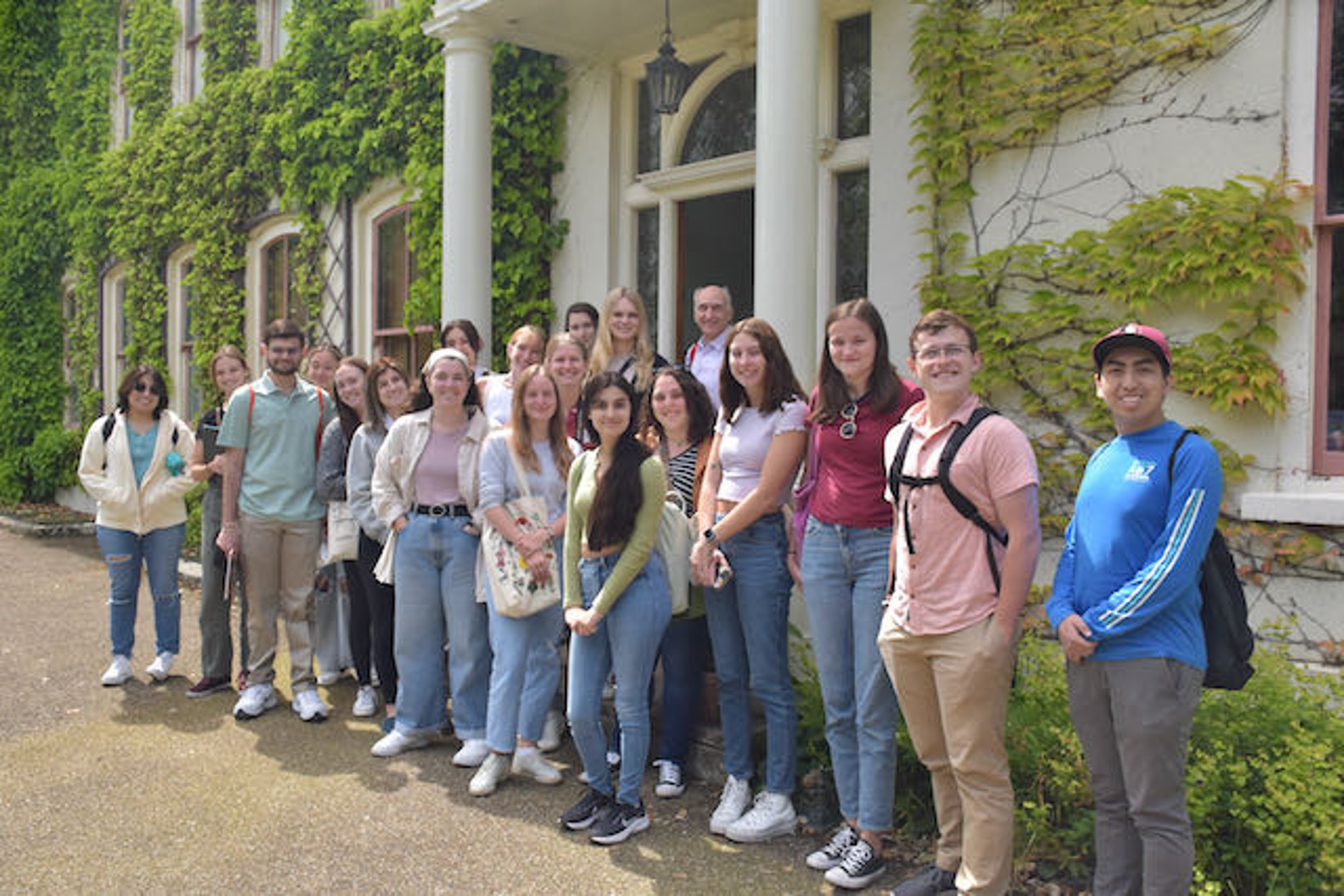This award will fund genomic sequencing work in Phyllotis to further our understanding of genotype-phenotype relationships in the genus, and also improve future genetics work in Phyllotis and Sigmodontinae more broadly. For more information on SSB and the award can be found at their website.
Scott Steppan, coordinator of the new Biology in London Program for study abroad, led the inaugural class by teaching Biogeography this June at the FSU London Study Centre. Nineteen students in biology or related majors explored London and the UK while learning about biogeography. Class excursions included behind the scenes visits with researchers at the Natural History Museum, Kew Royal Botanical Gardens, University College, London, and the home of Charles Darwin. This is the start of an annual summer program, so if you are interested in what classes will be offered in future years, just ask Dr. Steppan.
The Biogeography in London class at the home of Charles Darwin, Down House

Postdoc Max Bangs has designed a new genomic probe set specifically designed for rodents using anchored hybrid enrichment that has been published in Molecular Ecology Resources. Along with the probe sequences the article includes an easy-to-use methodology with little upfront cost along with a detailed list of supplies and costs needed to use this probe set. Our intention is to provide a simple, cost-effective tool for a diverse array of labs to be able to use for projects ranging from order to species. The Steppan lab already has three projects in the works using this probe set that have all produced great data.
While designed for rodents, the probe set should be useful for other eutherian mammal groups.
If you are interested check out the publication (DOI:10.1111/1755-0998.13555).
While conditions are far from normal, the lab was happy to be able to resume limited in-person lab meetings this summer.
Carl Saltzberg successfully defended. We wish him luck in his future endeavors.
A global pandemic can't stop science. Lab members presented virtually at two annual conferences this month: Scott, Max, Barbara, and Jared presented talks at American Society of Mammalogists, and Max and Barbara presented at the Evolution Meeting.
A National Geographic article by Douglas Main, covers the Steppan Labs work in identifying Phyllotis xanthopygus (the yellow-rumped leaf-eared mouse) as the the world's highest-dwelling mammal.
What began with an observation by mountain climbers of an unidentified rodent surrying about the desolate snow covered terrain near the summit of Llullaillaco, the worlds second highest volcano, would later be associated with environmental sampling and sequencing which confirmed inhabitation of this hostile habitat by P. xanthopygus.
To see the full article, including a video of the sighting on the volcano, click on the link below.
(opens in a new window)
The first peer-reviewed reports of the discovery of the highest elevation vertebrate (Phyllotis xanthopygus, the yellow-rumped leaf-eared mouse) has been published in the Proceedings of the National Academy of Science.
The Steppan lab has been collaborating with the original discoverers (Tom Bowen and Matt Farson), microbial biologists (Steve Schmidt and his lab at U. Colorado), and more recently a team of mammalogists (Jay Storz, Guillermo D’Elia, and colleagues), who have collectively established the world records first for mammals and then for all vertebrates, on this mountain.
See links for the paper, including videos from the 2020 discovery at the summit (6739 m, 22,110') and the 2013 discovery at 6,205 m (20,350’).
A National Geographic article by Douglas Main, covers the Steppan Labs work in identifying Phyllotis xanthopygus (the yellow-rumped leaf-eared mouse) as the the world's highest-dwelling mammal.
What began with an observation by mountain climbers of an unidentified rodent surrying about the desolate snow covered terrain near the summit of Llullaillaco, the worlds second highest volcano, would later be associated with environmental sampling and sequencing which confirmed inhabitation of this hostile habitat by P. xanthopygus.
To see the full article, including a video of the sighting on the volcano, click on the link below.
(opens in a new window)
The Steppan Lab welcomes Max Bangs who joined as a new postdoc researcher. Follow the links below to learn more about Max's research background and interests.
The Steppan Lab got a new website (this one).